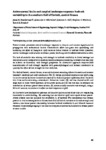Active normal faults and coupled landscape response: bedrock variability in the southern Gulf of Corinth, central Greece
| dc.contributor.author | Zondervan, JR | en |
| dc.contributor.author | Whittaker, AC | en |
| dc.contributor.author | Bell, RE | en |
| dc.contributor.author | Watkins, SE | en |
| dc.contributor.author | Brooke, SAS | en |
| dc.date.accessioned | 2020-09-15T08:57:28Z | |
| dc.date.available | 2020-09-15T08:57:28Z | |
| dc.date.issued | 2017-12-17 | en |
| dc.identifier.uri | http://hdl.handle.net/10026.1/16311 | |
| dc.description.abstract |
Fluvial erosion processes control landscape response to climatic and tectonic signals and its propagation into sedimentary basins. Considerable effort has gone into quantifying and modelling the effect of changes in uplift rates on fluvial erosion in bedrock rivers. However, current landscape models, based on stream power, tend to ignore the effects bedrock variability. The lack of available data relating rock strength to bedrock erodibility in fluvial settings has limited our ability to explore this question. Recent attempts at modelling to resolve this issue rely on indirect or theoretical rock strength properties. An alternative approach requires field measurements of rock strength together with geomorphological and tectonic constraints to quantify the effect of rock strength on river evolution. The Gulf of Corinth, central Greece, is one of the fastest extending rifts in the world and tectonic boundary conditions are well constrained. We (1) review published constraints on uplift along the active normal faults on the southern coast of the Gulf, and project uplift away from the faults into three catchments using a viscoelastic dislocation model; (2) test how channel width and slope vary in these rivers upstream of the active faults, and we use this data to estimate the distribution of stream power down-system; (3) systematically measure rock strength, using a Schmidt hammer, to constrain its effect on river response to uplift. All the rivers have knickpoints upstream of the active faults and we show they are responding transiently to active faulting. By assuming that our derived uplift rate equals stream power-driven erosion rate we calculate the erodibility, k, of bedrock. We demonstrate that stream powers in rivers crossing faults in the southern Gulf of Corinth correlate with rock strength and derive a non-linear power relationship between bedrock erodibility k and Schmidt hammer rebound. These findings highlight the need to incorporate bedrock variability into stream power erosion models. | en |
| dc.language.iso | en | en |
| dc.title | Active normal faults and coupled landscape response: bedrock variability in the southern Gulf of Corinth, central Greece | en |
| dc.type | Presentation | |
| plymouth.author-url | https://www.researchgate.net/publication/322266613_Active_normal_faults_and_coupled_landscape_response_bedrock_variability_in_the_southern_Gulf_of_Corinth_central_Greece | en |
| plymouth.organisational-group | /Plymouth | |
| plymouth.organisational-group | /Plymouth/Faculty of Science and Engineering | |
| plymouth.organisational-group | /Plymouth/Faculty of Science and Engineering/School of Geography, Earth and Environmental Sciences | |
| dc.publisher.place | Newcastle | en |
| dc.rights.embargoperiod | Not known | en |
| rioxxterms.licenseref.uri | http://www.rioxx.net/licenses/all-rights-reserved | en |
| rioxxterms.type | Other | en |


